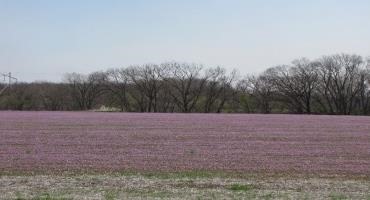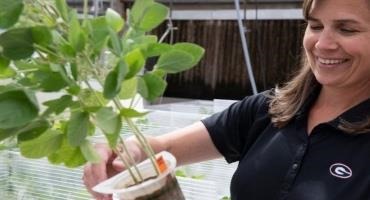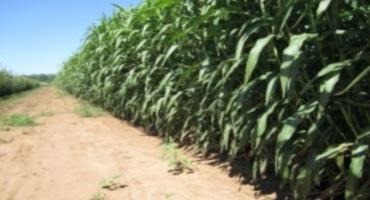Henbit originated in Europe and can be found throughout most of the world, except the tropics. It occurs throughout the United States, including all of Kansas, although it is more common in eastern Kansas. It grows in a variety of habitats, including lawns, gardens, rights-of-way, pastures, and fields.
Henbit is frequently observed in fallow fields (Figure 1) and in winter wheat or winter canola fields. Even though henbit generally does not reduce crop yields, it can interfere with planting operations for summer crops and can be host to soybean cyst nematodes, plant pathogens, spider mites, and ear worms. There are some reports of toxicity to sheep, horses, and cattle in Australia, but no reports have been confirmed in the US.

Figure 1. Henbit growing in a fallow field. Photo by Dallas Peterson, K-State Research and Extension.
Identification of henbit
Round cotyledons, 0.1 to 0.5 inches long, have a notch where they attach to hairy petioles (Figure 2). Seedling stems are initially green, but become maroon as the plant ages. The first true leaves are heart-shaped and oppositely arranged with fine hairs on the upper surface and along the veins of the lower surface. First leaves are attached to the stem by petioles, but as the plant matures, leaves are sessile, meaning they are directly attached to the stem. Upper leaves have rounded teeth along the margins and encircle the stem (the genus name amplexicaule comes from the Latin word meaning “embracing the stem”). Upper leaves are often closer together on the stem than lower leaves. The upper surface of both young and mature leaves has prominent veins and fine hairs and appears crinkled.

Figure 2. Henbit seedlings. Photo by Sarah Lancaster, K-State Research and Extension.
One identifying feature of mints is that mature stems are square, which is the case for henbit. Mature stems are 4 to 16 inches long and have sparse hairs. Stems will form adventitious roots at lower nodes that are in contact with the soil.
Showy lavender flowers are most abundant in the spring (Figure 3). They have a distinct shape consisting of a long tube and a flared ‘hood’ at the end. They are produced in whorls near the top of the plant.
Four egg-shaped seeds 1. 5 to 2 mm long are produced in each fruit. Seeds are three-sided and brown with white spots. Each plant can produce over 2,000 seeds that generally remain viable for about 5 years, but can live up to 25 years in the soil.

Figure 3. Henbit flower. Photo by Sarah Lancaster, K-State Research and Extension.
Purple deadnettle is a similar species that occurs in parts of Kansas. It can be distinguished from henbit by triangular upper leaves that are maroon in color. Purple deadnettle is not found in western Kansas and is more likely to be found in shaded areas.
Management
Henbit is easily controlled by herbicides during fall and very early spring. Residual herbicides will prevent emerge through the spring. Research conducted in Louisiana suggest that flumioxazin (Valor, others) or S-metolachlor (Dual products, others) applied in the fall can provide henbit control henbit through early spring. In wheat, henbit can be controlled by chlorsulfron (Glean, others) and metsulfuron (Ally, others) applied before henbit starts to bloom. ALS-resistant henbit was reported in Kansas in 2014, so pyrasulfotole (Huskie) may result in better control in some fields. Fall applications of 2,4-D did not provide good henbit control in studies conducted in Kansas during 2006.
Some non-chemical control options include tillage in late fall or early spring, after plants have emerged. Early fall tillage, before emergence, may increase germination. Increased plant populations can be used to suppress henbit in wheat.
Source : ksu.edu